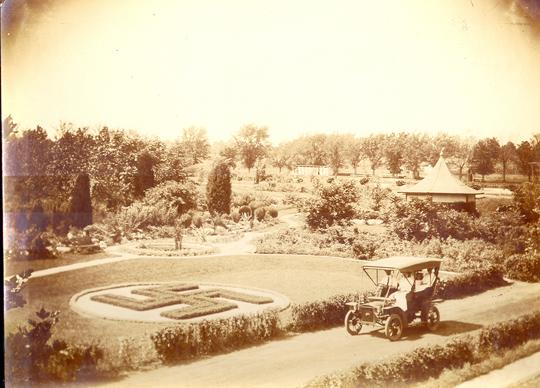Parks from the past

March 9, 2011
Topekans have a variety of entertainment at their disposal. While modern day Topeka takes for granted its choices, city founders adopted a philosophy early on of preserving parks for recreation since the city’s birth.
In 1854, a pioneer carpenter named Anthony Ward moved to an area along the Kansas River. Along with his fellow settlers, Ward founded the city of Topeka.
It wasn’t until after Ward and his son-in-law, John Meade, passed away that the land his homestead rested on became the centerpiece of the modern day Topeka Parks and Recreation services. With the donation of the area that is today known as Ward-Meade Park and the establishment of City Park along the south bank of the river running through downtown, the roots of the modern Parks and Recreation Department took hold.
It wasn’t until much later that the system of over 120 parks would collect some of today’s more notable parks like Gage and Garfield Park.
“Initially, the parks system was just a lot of pieces of small land that were donated by some of the city founds like Cyrus K. Holliday with Holiday Park,” said Bill Riphahn, director of planning and development for City of Topeka’s Parks and Recreation Department.
The process of organizing the pieces of land that the city acquired over time eventually fell to a man of Prussian decent named E.F.A. Reinisch. He was a horticulturalist who took up residence in Gage Park around the turn of the 19th century, a piece of land that had cost several local politicians dearly according to Riphahn.
“At the time that Gage was acquired from the Gage family, the park was almost four miles outside the city limits,” said Riphahn. “Several members of the city council lost reelection over the acquisition but later when the trolley came to Topeka and made the trip out there easier, it was celebrated as a great deal.”
Reinisch took advantage of the natural surroundings, using rails from a failed train experiment to create a giant sundial as well as use his skills to craft intricate shrubbery art. Included in the art seen throughout the park was a symbol of good tidings that today carries a different symbolic meaning.
“Being from Germany, Reinisch put a giant swastika in the shrubbery art,” said Riphahn. “Back in those days, right before World War I, that symbol represented good luck. The swastika was something positive long before Hitler ever came along.”
After Reinisch’s time as parks commissioner, the next notable character in for Parks and Recreation would be a man by the name of Harry Snyder. Having made his money as a used car salesman, Snyder’s sense of humor and vision were at times abrasive to others in the community.
“Snyder’s contribution to Parks and Rec was the beginnings of what became the zoo system in Topeka,” said Riphahn. “One of the exhibits he started was Monkey Island, which was a monkey exhibit that had a castle looking structure with windows and each window had a label on it like, ‘Police Chief, Mayor and so on.”
One of the other interesting instances of Snyder’s humor came at the infant stages of the zoo as Snyder acquired a bear from a traveling circus and had tied it to a tree in Gage Park while he began the process of building proper cages for it.
“Harry Snyder had gotten a tame bear from the circus,” said Riphahn. “It was named Tom, and was one of those bears you could pay $2 to wrestle. So when Snyder brought the bear to Gage, it would get loose sometimes and the neighbors would inevitably call Snyder telling him that ‘Ol’ Tom had gotten out again.'”
Another of the evolutions of the park system was the swimming pool, which started with Gage Park’s original pool. The original pool was located where the parking lot for the Topeka Zoo currently resides.
“Originally, kids were swimming in an old pond and the authorities that be decided to cement along the edges of it to give people a reason to walk along it and hopefully discourage the kids,” said Riphahn. “It ended up just making it more popular and eventually they would cement the sides as well creating a pool that could hold quite a few people.”
Besides swimming, the pools also served as a site for the annual Halloween party. Snyder emptied out the pool and held a barnyard party with cows, chickens and other livestock in the deep end of the pool.
In the following years, Parks and Recreation continued moving forward, with the community facing the growth of the city through the absorption of parks such as Garfield Park. The creation of spaces like Lakewood Park for minorities also helped expand what used to be a segregated city. As Topeka progressed, both physically as well as socially, so have the parks alongside it.
Topeka’s outdoor entertainment options grew from a small affair into today’s system of over 120 parks scattered throughout the city. Going forward, Topeka’s parks still will play a vital role in the growth of the community. Currently, the city has plans to extend the walking paths into interconnecting trails that will make the city more walker friendly. The city also is continuing to help develop the Kansas Children’s Discovery Center that will open to the public in Gage Park this coming summer.
“We’ll still be working on things that will help create a space for people to enjoy their city,” said Riphahn.


